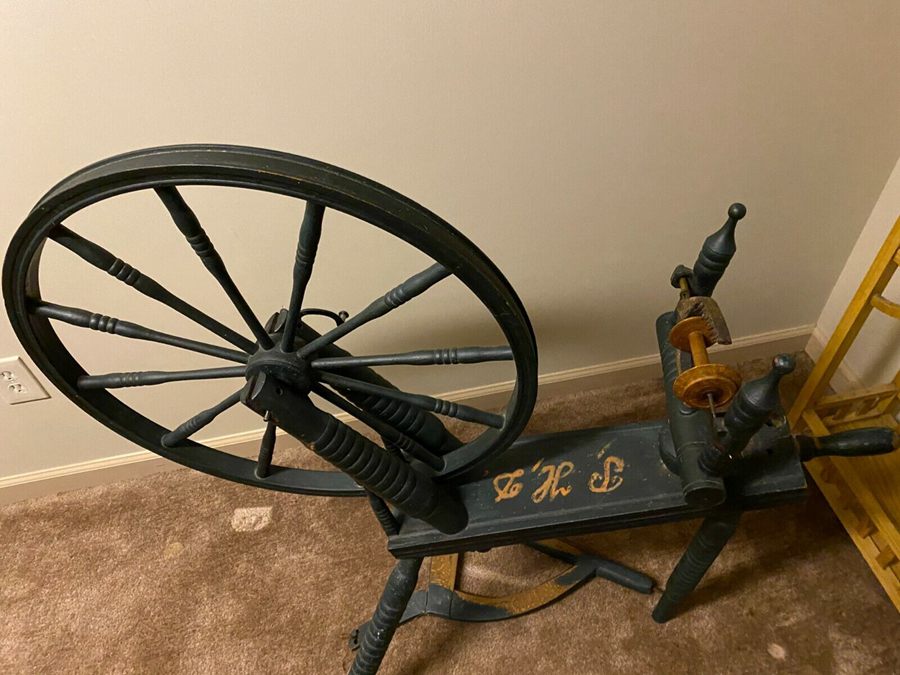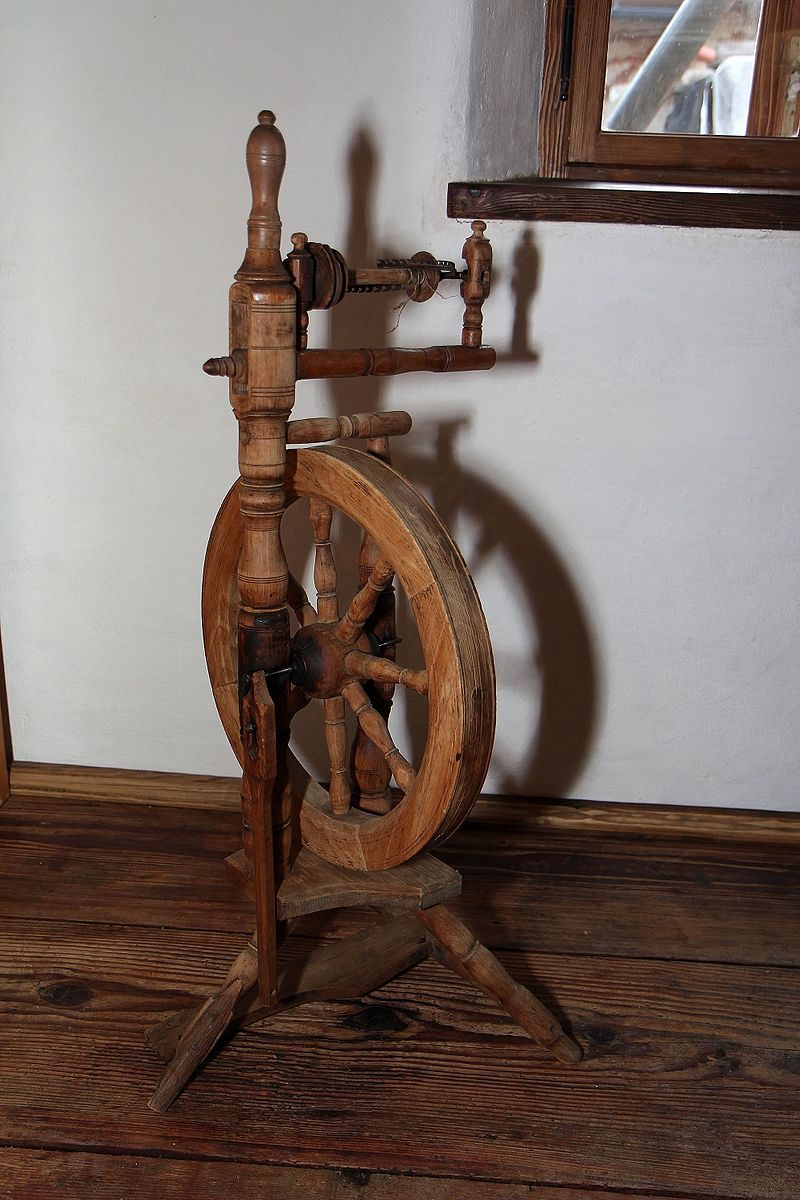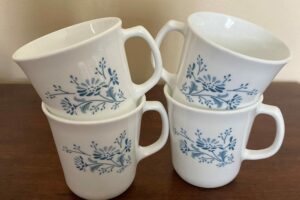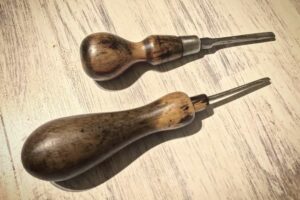Antique spinning wheels are fascinating collectibles that not only tell an important story about our past but can also be worth a pretty penny when properly identified and valued. Invented in China around 1030 AD, these spinning wheels revolutionized the textile industry by allowing threads and yarns to be spun from raw fibers much more efficiently than the previous methods. Delving into the world of antique spinning wheels can be both an educational and profitable endeavor, and in this article, we will help you navigate this captivating field.
Before attempting to identify and value an antique spinning wheel, it’s essential to know what to look for. Key factors in assessing the age and origin of a spinning wheel include the wheel diameter, design features, and in some cases, maker’s marks. Typically, if a wheel is between 13 and 24 inches in diameter, it’s considered highly valuable, with prices reaching up to $600. Conversely, smaller wheels might fetch between $150 and $200. Familiarizing yourself with known spinning wheel styles and regional variations will go a long way in enabling you to make the most accurate assessments.
Embarking on this journey to uncover the hidden value and stories behind antique spinning wheels, it’s crucial to arm yourself with expert advice and conduct thorough research. Remember, the payoff can be both educational and financial, and by gaining a deeper understanding of these remarkable machines’ history and value, you can confidently and accurately evaluate your finds. Happy hunting!
Table of Contents
The History & Evolution of Antique Spinning Wheel
In the history of textile production, the spinning wheel is an essential invention that greatly impacted human society. Your journey through the evolution of spinning wheels begins with the ancient spindle, a simple stick used to twist fibers into yarn. It dates back to the Neolithic period, around 10,000 BCE. The basic spindle evolved into more complex tools, eventually leading to the development of spinning wheels.
The first evidence of actual spinning wheels comes from the 11th century in China and India. The charkha, a hand-operated spinning wheel, was widely used in Indian villages and became a symbol of the Indian struggle for independence.
By the 13th century, spinning wheels had reached Europe, where they were constantly evolving and becoming more efficient. The Saxony wheel, also known as the flax wheel, emerged in the 16th century. This type predominantly had a single drive wheel, while the great wheel, also known as the walking wheel, utilized a larger drive wheel and was commonly used to spin wool.
In the 18th century, the spinning wheel saw further innovations. The flyer-and-bobbin system, which allowed for continuous spinning without the need to stop and wind yarn, was a particularly important advancement. This system laid the foundation for the development of the spinning jenny, a significant milestone in the Industrial Revolution.
Key spinning wheel features for identification:
- Material: Most antique spinning wheels were made of wood, with some metal components
- Drive System: Single drive (twist and wind-on in one action) or double drive (separate belts for spinning and winding)
- Treadle: Presence or absence of treadles, which are foot-operated pedals
- Flyer: The spinning mechanism that twists and winds the fiber into yarn
- Bobbin: The spool that holds the spun yarn
Antique spinning wheel values can vary greatly depending on factors such as age, condition, rarity, and regional origin. It’s essential for you to closely examine the spinning wheel and consult reputable resources, such as antique guides or reliable online sources, to help determine the value of your antique. While research can aid in determining the wheel’s value, consider consulting with an antique expert for a more accurate evaluation.
How to tell if Spinning Wheel is Antique or old
To determine if your spinning wheel is antique or old, follow these steps:
- Examine the craftsmanship: Check for asymmetrical pieces, which can indicate the wheel’s genuine age due to the lack of production standards when most antique spinning wheels were created.
- Look for signs of use: Focus on parts like the treadle and flyer that would be heavily manipulated. Any obvious signs of wear can help you determine if the spinning wheel is old.
- Measure the wheel: Using a tape measure, find the diameter of the wheel. Antique and precious spinning wheels are generally 13 to 24 inches in diameter and can cost up to $600. If the diameter is less than 13 inches, the wheel is likely newer and valued at around $150 to $200.
- Check for built-up lint or grease: Investigate the orifice where the wool passed through during spinning since most women didn’t clean those parts thoroughly. Built-up lint or grease can be an indicator of age and use.
- Inspect the wood: Look for signs of woodworm infestations by searching for clusters of tiny holes where beetles have gnawed through the wood. This can give you insight into the spinning wheel’s age and condition.
By examining these factors, you can gather a better understanding of whether your spinning wheel is antique or old. Remember, proper identification can greatly affect the value of an antique spinning wheel.
6 Types of Antique Spinning Wheel and Their Values
Saxony Wheel
The Saxony Wheel is a popular and classic type of spinning wheel. This horizontal wheel usually has a single or double treadle and is made from various materials including wood, metal, or stone. The value of a Saxony Wheel can range from $300-$500, depending on its condition, materials, and age.
Great Wheel or Walking Wheel

The Great Wheel or Walking Wheel is one of the oldest types of spinning wheels. It is also known as the Wool Wheel, as it was used for spinning wool primarily. This vertical wheel has a large drive wheel and no treadle, making it unique among antique spinning wheels. Its value can vary greatly depending on factors like size, craftsmanship, and rarity, ranging from $300-$1,500.
Norwegian Wheel
The Norwegian Wheel is a compact, upright spinning wheel with intricate wood carvings and a distinct design. It is often made of birch or other types of light-colored wood. The value of a Norwegian Wheel can range from $400-$600, based on its condition, craftsmanship, and historical significance.
Irish Castle Wheel
The Irish Castle Wheel is named for its resemblance to the towers of Irish castles. This vertical spinning wheel has a compact design, often with two or more flyer assemblies or multiple bobbins. It can be made of various materials like wood, metal, or stone. Prices for Irish Castle Wheels can be quite variable, usually ranging from $500-$1,200.
Charkha or Spindle Wheel
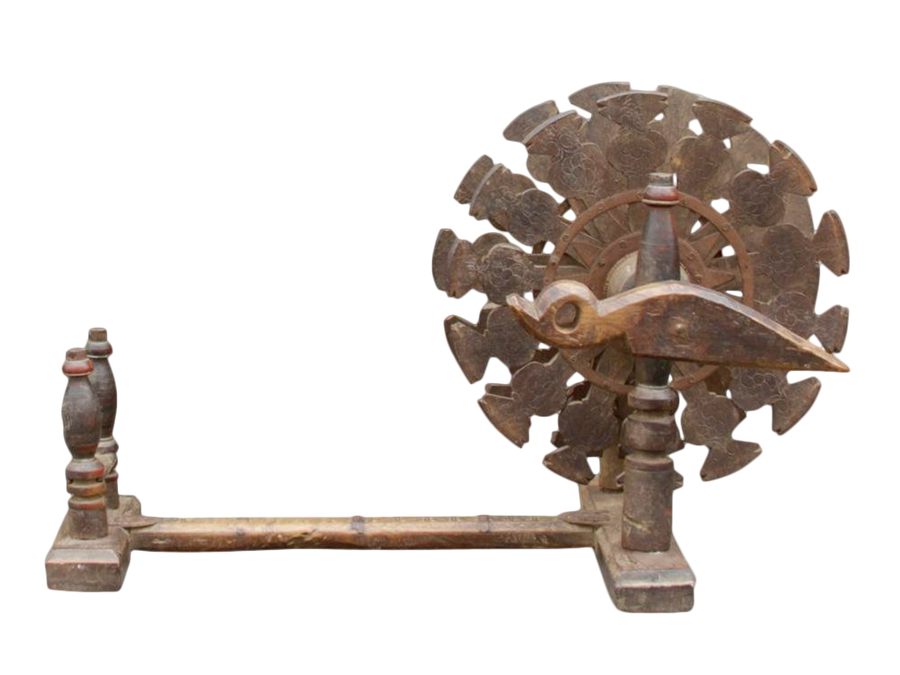
The Charkha or Spindle Wheel is a small, often portable spinning wheel that originated in India. It was commonly used for spinning cotton and other fine fibers. This spinning wheel has a horizontal spindle, instead of a flyer mechanism, which makes it unique among spinning wheels. The value of a Charkha can range from $100-$300, depending on factors like age, materials, and condition.
Flax Wheel
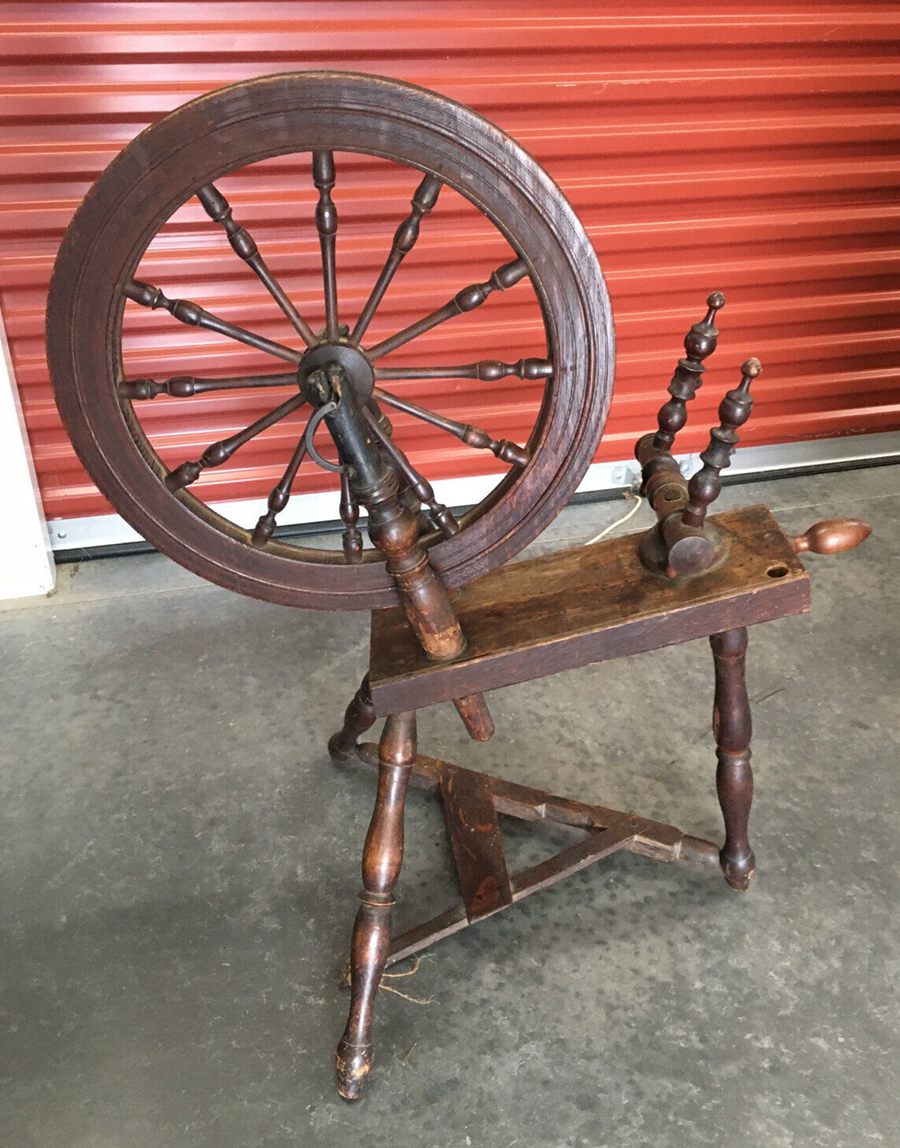
The Flax Wheel is specifically designed for spinning flax fibers and has a more delicate and compact appearance than other spinning wheels. It often features a distaff for holding the fibers and a single treadle. The value of a Flax Wheel can range from $250-$500, based on factors such as age, materials, and craftsmanship.
5 Factors to Identify & Value Antique Spinning Wheels
1. Rarity
The rarity of antique spinning wheels plays a significant role in determining their value. Several factors contribute to the rarity of these items, such as the age, design, materials used, and level of craftsmanship.
Age
Generally, the older an antique spinning wheel is, the rarer and more valuable it may be. Spinning wheels from the 17th and 18th centuries, for example, could have a higher value compared to those made in the 19th century.
Design
Unique and intricate designs can significantly impact the value of antique spinning wheels. Those featuring ornate carvings or unusual shapes are often considered more valuable than those with simple, standard designs.
Materials
The materials used in the creation of the spinning wheel can also affect its value. Wheels made from fine wood or those that feature brass, ivory, or other uncommon materials may fetch higher prices compared to those made from more common materials.
Craftsmanship
High-quality craftsmanship, as demonstrated by the precision and intricacy of the spinning wheel’s construction, can also increase its value. Handcrafted and well-made spinning wheels are often considered more valuable and rarer than those made using machine production techniques.
Based on the factors mentioned above, the following is a general valuation table for antique spinning wheels:
| Factors | Average Valuation |
|---|---|
| 17th or 18th Century, Simple Design | $300 – $400 |
| 17th or 18th Century, Ornate Design | $500 – $600 |
| 19th Century, Simple Design | $200 – $300 |
| 19th Century, Ornate Design | $400 – $500 |
| Uncommon Materials | $350 – $450 |
| High Craftsmanship | $400 – $500 |
Keep in mind that these valuations are only meant to serve as a reference and can vary depending on the specific spinning wheel and its overall condition. It is advisable to consult with an antique expert or appraiser to get a more accurate estimation of your antique spinning wheel’s value.
2. Old Spinning Wheel Materials
When assessing the value of antique spinning wheels, several factors play a crucial role. One of these factors is the materials used in the construction of the wheel. As a collector, understanding the different materials and how they affect the wheel’s value is essential. In this section, we’ll discuss a few common materials used in antique spinning wheels and provide a valuation table for each.
Wood
Wood is perhaps the most common material used in antique spinning wheels. The type of wood used can greatly affect the wheel’s value. Hardwoods such as oak, maple, and walnut were often used for their durability and beauty. These hardwoods can increase the value of the spinning wheel when compared to those made from softwoods like pine.
| Wood Type | Average Valuation |
|---|---|
| Oak | $300 – 400 |
| Maple | $350 – 450 |
| Walnut | $400 – 500 |
| Pine | $200 – 300 |
Metal Components
Antique spinning wheels often include metal components, such as treadles, sliding tensioners, and footmen. These metal parts can also impact the wheel’s value. Wheels with original, well-maintained metal components typically hold a higher value than those with rusted or replaced parts. Additionally, wheels marked with a maker’s mark carry more value than unmarked wheels.
| Metal Conditions | Average Valuation |
|---|---|
| Original, Well-Maintained | $350 – 450 |
| Original, Rusted | $250 – 350 |
| Replaced | $200 – 250 |
| Marked with Maker’s Mark | $400 – 500 |
Flyer Assembly
The flyer assembly is another crucial factor when determining the value of an antique spinning wheel. When inspecting a flyer assembly, both the bobbin and flyer should move freely and independently from each other. Wheels with fused bobbin and flyer assemblies have a lower value, as they are better suited for decorative purposes rather than functional spinning.
| Flyer Assembly Condition | Average Valuation |
|---|---|
| Free-Moving, Independent | $300 – 400 |
| Fused Together | $100 – 200 |
By acknowledging these factors and their impact on value, you can make informed decisions when assessing antique spinning wheels. Remember that condition and rarity also play a significant role in the overall value. As you gain experience, you’ll develop a better eye for identifying and valuing these beautiful pieces of craftsmanship.
3. Vintage Spinning Wheel Brands
When exploring the value of antique spinning wheels, it’s important to understand how different vintage spinning wheel brands can impact the overall worth of your piece. This section will delve into some notable brands that may affect the value of your antique spinning wheel.
Plocher
Plocher was a renowned spinning wheel maker known for its high quality and intricate design. It was founded in the early 18th century and produced some of the finest spinning wheels that were sought-after in the market. Identifying a Plocher spinning wheel can add significant value to your antique.
Average Valuation Table for Plocher:
| Wheel Type | Average Valuation |
|---|---|
| Saxony Wheel | $800 – 1,000 |
| Upright Wheel | $750 – 900 |
| Great Wheel | $500 – 650 |
LeClerc
LeClerc is a Canadian spinning wheel manufacturer with a long history of producing high-quality spinning wheels and looms. The brand’s spinning wheels are recognizable by their unique design and often include maker’s marks which can increase the value of your antique.
Average Valuation Table for LeClerc:
| Wheel Type | Average Valuation |
|---|---|
| Saxony Wheel | $700 – 900 |
| Upright Wheel | $650 – 800 |
| Great Wheel | $450 – 550 |
Haldane
Haldane is a Scottish spinning wheel manufacturer, celebrated for their distinct design and attention to detail. Their spinning wheels are often valued higher due to their stylistic attributes and overall craftsmanship.
Average Valuation Table for Haldane:
| Wheel Type | Average Valuation |
|---|---|
| Saxony Wheel | $900 – 1,200 |
| Upright Wheel | $850 – 1,000 |
| Great Wheel | $600 – 750 |
Keep in mind that there are numerous factors that can affect the value of your antique spinning wheel, such as age, condition, provenance, and rarity. Be sure to consider these aspects as you evaluate the worth of your spinning wheel.
4. Old Spinning Wheel Condition
It is crucial to evaluate the condition of an antique spinning wheel to determine its value. Various factors, such as the wheel’s size, markings, and overall condition, significantly impact its worth. Below are some primary conditions for you to assess when evaluating antique spinning wheels.
Wheel Size
The size of the spinning wheel can provide a clue about its age and value. Typically, larger wheels are older and more valuable. Measure the diameter of the wheel to get an idea of its worth:
| Wheel Diameter | Average Valuation |
|---|---|
| 13 – 24 inches | $400 – $600 |
| Less than 13 inches | $150 – $200 |
Wheel Markings
Many antique spinning wheels are marked with a maker’s mark. This mark can give you insights into the wheel’s age, rarity, and manufacturer, which can affect its value. Look for the maker’s mark and research its significance if you find one.
Overall Condition
The spinning wheel’s overall condition is a significant factor in determining its value. Fully functioning and well-preserved wheels command higher prices. Keep an eye on features like mismatched legs, missing treadles, footmen, and flyer assembly, as they indicate the wheel may not be in working condition.
Here’s a basic valuation guide based on the general condition of the spinning wheel:
| Condition | Average Valuation |
|---|---|
| Fully restored and functional | $300 – $350 |
| Functional but needs restoration | $200 – $250 |
| Non-functional and needs restoration | $100 – $150 |
When examining antique spinning wheels, keep these factors in mind to help you accurately assess their value. Use this information to your advantage when buying, selling, or simply appreciating the history and craftsmanship behind antique spinning wheels.
5. Old Spinning Wheel Styles
When identifying and valuing antique spinning wheels, it is crucial to consider the different styles and their impact on the wheel’s worth. This section will discuss the main styles of old spinning wheels and provide a valuation table for each of the factors that influence value.
Different Antique Spinning Wheel Styles
- Great Spinning Wheel: Large and often found in European countries like the United Kingdom, France, and Germany. They facilitate high-output spinning and are historically valued.
- Saxony Spinning Wheel: Originating from the German region of Saxony, this style features a horizontal “mother-of-all” or main drive wheel that connects to a vertical “flier” or spindle.
- Norwegian Spinning Wheel: Unique for their intricate carvings and high-quality craftsmanship, these wheels were primarily used in Scandinavian countries.
- Charkha: Small and portable, Charkha-style wheels were popular in India and are often considered the most valuable.
- Castle Spinning Wheels: Compact with a vertical orientation, castle wheels are designed for easy storage and transport.
- Spinning Jenny: An innovative spinning wheel style that allowed for multiple spindles to be spun simultaneously, making them historically significant.
Valuation Table for Antique Spinning Wheel Styles
| Antique Spinning Wheel Style | Average Valuation |
|---|---|
| Great Spinning Wheel | $250 – $400 |
| Saxony Spinning Wheel | $150 – $300 |
| Norwegian Spinning Wheel | $200 – $450 |
| Charkha | $350 – $550 |
| Castle Spinning Wheels | $100 – $200 |
| Spinning Jenny | $600 – $850 |
Remember that these valuations are just rough estimates and can vary depending on factors such as the wheel’s age, condition, rarity, and craftsmanship. It is essential to thoroughly examine each antique spinning wheel to determine its true value accurately.
6. Antique Spinning Wheel’s Markings and Signatures
When identifying and valuing antique spinning wheels, it’s essential to pay attention to their markings and signatures. These may include inscriptions, maker’s marks, or other unique identifying factors. Various factors affect the value of a spinning wheel, and knowing these details can help you gauge its worth more accurately.
Here are some factors that may affect the value of your spinning wheel, along with a valuation table for each factor:
Age of the Spinning Wheel
Older spinning wheels tend to have a higher value than more recent ones. Look for signs of aging, such as wear on the wheel or the materials used in construction, to help determine the age.
| Age of Spinning Wheel | Average Valuation |
|---|---|
| Pre-1800s | $600 – 800 |
| 1800s – Early 1900s | $400 – 600 |
| Mid-20th Century | $200 – 400 |
Wheel Type
Different spinning wheel types have varying values. Some examples include the Great Wheel, Saxony Wheel, Charkha, and Castle Wheel. Research the specific features for each wheel type, and compare them to your antique spinning wheel.
| Wheel Type | Average Valuation |
|---|---|
| Great Wheel | $700 – 900 |
| Saxony Wheel | $600 – 800 |
| Charkha | $800 – 1000 |
| Castle Wheel | $500 – 700 |
Material & Finish
The materials used in the construction of a spinning wheel, as well as its finish, can significantly impact its value. Check for materials like metal or wood; older spinning wheels may have a clear shellac finish, while later ones used a lacquer or varnish.
| Material & Finish | Average Valuation |
|---|---|
| Wood, Shellac Finish | $500 – 700 |
| Wood, Varnish Finish | $400 – 600 |
| Metal, Lacquer Finish | $300 – 500 |
Condition
The spinning wheel’s overall condition will also determine its value. Wear and tear is normal for an antique, but excessive damage, missing parts, or signs of poor restoration can negatively affect the wheel’s value.
| Condition | Average Valuation |
|---|---|
| Excellent, Minimal Wear | $800 – 1000 |
| Good, Moderate Wear | $500 – 700 |
| Fair, Significant Damage | $200 – 400 |
By considering these factors and referring to these valuation tables, you can gain a better understanding of the value of your antique spinning wheel. Remember to always take a close look at any markings or signatures to help in identifying and valuing your spinning wheel.
7. Antique Spinning Wheel Size
When it comes to antique spinning wheels, size is an essential factor that affects their values. Many antique collectors and enthusiasts look for spinning wheels with particular dimensions and characteristics, making size an essential component when evaluating these pieces.
The average valuation of antique spinning wheels depends on the diameter of the wheel. You can quickly determine the value of a spinning wheel by measuring the diameter of the wheel and referring to the table below.
| Wheel Diameter | Average Valuation |
|---|---|
| 13 – 24 inches | $500 – 600 |
| 10 – 12 inches | $450 – 500 |
| 7 – 9 inches | $300 – 350 |
| 4 – 6 inches | $100 – 120 |
An antique spinning wheel with a larger wheel diameter, ranging from 13 to 24 inches, suggests that it is not only old but also precious. Spinning wheels within this size category can fetch up to $600. On the other hand, spinning wheels with smaller diameters, such as less than 13 inches, may be less valuable, ranging between $100 and $200.
Additionally, you should pay attention to the materials used in the spinning wheel’s construction. The earliest spinning wheels were made entirely of wood, while later models may include metal or plastic parts. Antique spinning wheels made solely of wood are generally more valuable than those with contemporary additions, so it’s crucial to examine the craftsmanship and materials when determining the value of a spinning wheel.
In conclusion, evaluating antique spinning wheels takes some knowledge of different factors such as size, materials, and overall craftsmanship. By understanding these elements and using the valuation table, you can make a more informed assessment of the value of antique spinning wheels in your collection.
Final Thoughts
As you explore the world of antique spinning wheels, remember that identifying and valuing these items can be both rewarding and challenging. By arming yourself with the knowledge of a few key characteristics, such as the size of the wheel and the type of spindle, you can make the process much simpler.
When examining an antique spinning wheel, start by measuring the diameter of the wheel. If it’s between 13 and 24 inches, it could be a valuable piece worth up to $600. On the other hand, smaller wheels may be less expensive, ranging between $150 and $200.
Additionally, take note of the materials used and the craftsmanship. Authentic antique spinning wheels were typically made from wood and were crafted with great attention to detail. They may feature intricate carvings or inlays that could help you learn more about the origin and era of the piece.
To further expand your knowledge and refine your identification skills, consider investing in resources such as books and antique collector magazines. These can provide valuable information on historical spinning wheel styles, designs, and values.
Lastly, don’t forget to appreciate the beauty and history of these fascinating tools. Connecting with our past through antique spinning wheels allows us to better understand the evolution of textile production and appreciate the ingenuity of our ancestors.
Good luck in your antique spinning wheel identification journey; with practice and patience, you will become an expert in this fascinating field.
FAQ
How can I identify the age of my antique spinning wheel?
To identify the age of your antique spinning wheel, observe the overall design, shape, and style of the wheel. Spinning wheels went through various design changes over the years, which can help narrow down their age. Look for maker’s marks, which might provide further information about the wheel’s age and origin.
What are the value ranges of antique spinning wheels?
The value of an antique spinning wheel can vary depending on its condition, rarity, and size:
- If the wheel’s diameter is between 13 and 24 inches, it could be worth up to $600
- Wheels with a diameter smaller than 13 inches might be worth $150 – $200
- Rare items in excellent condition can reach prices of $600 to $850
- Unique pieces, such as the Charkha spinning wheel used by Mahatma Gandhi, can have an estimated value of $75,000
What are some common features to look for when identifying an antique spinning wheel?
- Size: Measure the wheel’s diameter to determine whether it’s old and valuable.
- Design: Take note of any unique elements in the design, such as unusual patterns or carvings.
- Material: Antique spinning wheels were typically made from materials like wood, metal, and sometimes even bone.
- Maker’s mark: This can provide information about the wheel’s age and origin.
Where can I find more information about antique spinning wheels?
Some valuable resources for further information on antique spinning wheels include:
- PLY Magazine (Antique Wheel Resources) – Provides information on wheels and antique looms, including details on maker’s marks and historical context.
- The Spinning Wheel Sleuth – Offers various knowledge on wheels and, especially, antiques, covering both antique spinning wheels and looms. You may consider purchasing a subscription for in-depth information.


